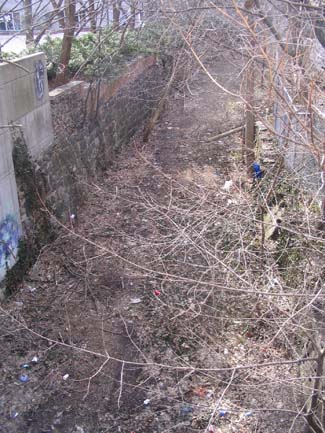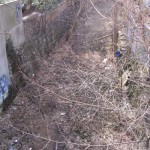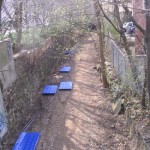By STEPHEN V. KOBASA
Wearing a white linen suit, Theodore Roosevelt sits inside the metal cab of a steam shovel during his visit to the newly dug Panama Canal. The workers in the photograph hardly register - they are edges to the frame of the bright, imperious centerpiece. And those invisible men share their vanishing with the masons who fashioned the retaining walls which survive of the abandoned Farmington Canal in New Haven, Connecticut.
Their memory is not entirely restored in the site installation recently created for that space by Matej Vogrincic. Perhaps it could not be. Hard labor is transient. As material as the result may be, the actual physical cost is not a part of the reference we make when confronting it. Even the work of the artist on this particular piece - the logistics of clear cutting and trash removal; the heaping up of gravel and clam shells and bricks - is not self evident.
And while there may be photographs and film records of the work in progress, they are accidental histories which are not integral to the piece. The project might have struggled to completion, or have been laid out in a matter of moments. On the evidence of the site itself, there is no way of distinguishing.
Any work of art contains this paradox of hidden time; its illusion of the miraculous. But that does not mean that we should always be taken in. There is something about those 19th century ditch diggers that demands remembering in specific terms which this work can only partially grant. And the ranks of stone which they fitted together should be read as more than a convenient setting for a current fantasy.
While Vogrincic was drawn to this location by its past - a water transportation project of the early 1800's which failed, later to be replaced by a railway line itself now obsolete - his excavation of the site (in which, for the sake of full disclosure, I was a sometime participant) did more to erase than expose. There were artifacts - from railway spikes to a frustrated thief's laptop computer, but they were not a part of the artist's anticipated story.
There is a pastiche working here, with the children's Erector Sets of New Haven's W.C. Gilbert Company serving as templates for the sinkable vessels filled with archetypes of cargo. But the sense of surprise at the center of Vogrincic's earlier works - ranks of plaster watering cans in the Australian desert, or a Venetian house, its exterior walls covered with clothing - is muted here. The overturned boats with which he filled the bombed out shell of St. Luke's Church in Liverpool evoked losses at sea and fishers of men precisely by being out of place. Here, the mock craft are predictable, not revelatory.
But this does not mean that the installation is powerless. A parenthesis to the untitled piece notes that "It used to be my playground." But it was never a place for games. The punched-out metal forms that frame the boats have a malevolent shine to them. They are like Charon's toys, meant for modern dead crowding into the underworld.
And the assembly line is evoked - not simply in the duplication of forms which Vogrincic has used previously - but in the briefly immobilized procession that has a touch of infinity lent to it by the open-mouthed darkness at either end of the canal's length. There may be a sorcerer's apprentice at work here - his magic run amuck - leaving us to face a threat both impassive and unstoppable.
For romantics, this is an ominous tunnel of love, inside which the lovers have jumped ship - victims of some accident of the hidden machinery or mutual suicides.
Beginning and end are unstable here - are the boats coming or going, in retreat or invading, bringing gifts or escaping with plunder? The ambiguity cancels out the cliché of the work, leaving us with our carefully considered fears of what lies underground. That may well serve as a witness to the diggers who originally made this space and the harm many of them must have come to. Their experience would have been close enough to damnation. As it must have been for the community of homeless who sheltered here this past winter. Standing on one of the bridges above the installation we look in vain for a coin slot that might click open a door to hell.
- Threee stages of change: transforming the abandoned Farmington Canal in New Haven, Connecticut.
"Untitled (It used to be my playground)," Farmington Canal site, New Haven, CT, through mid- September.
All images are courtesy of the artist.







